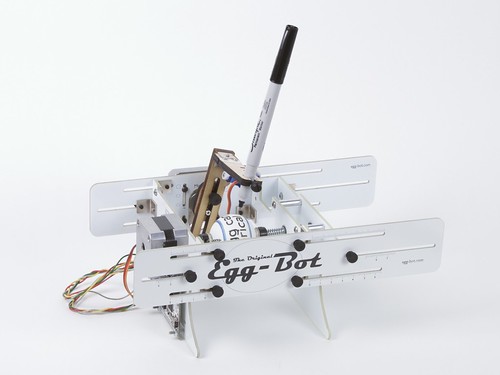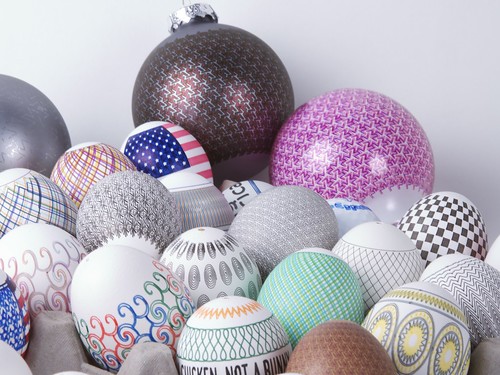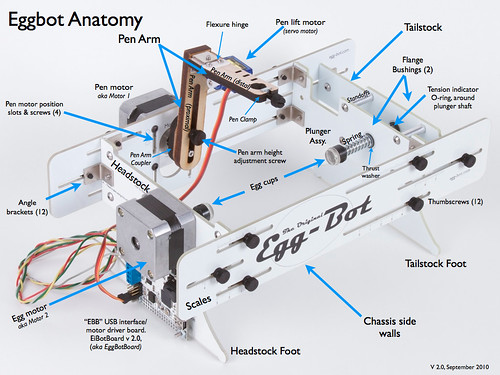"Evil Mad Scientist Laboratories" - 1 new article
The Egg-Bot KitWe have mentioned Eggbot several times this year as we demonstrated it at Maker Faires in San Mateo and Detroit, as well as at the California state fair. And today, we're very pleased to (finally) reveal the the design of our new kit. So what's an Eggbot? It's a machine capable of drawing on spherical or ellipsoidal surfaces. You might say, a pen plotter for spherical coordinates. Or a simple but unusual CNC machine, ripe for hacking. Or an educational robot-- and you'd be right on all accounts. It's worthwhile to point out that there's actually quite a bit of history here in this project. The Eggbot kit is the result of our collaboration with Bruce Shapiro, Ben Trombley, and Brian Schmalz. Bruce designed the first Eggbot back in 1990, and there's been a process of continuous evolution ever since. The Eggbot has a rigid but adjustable chassis that allows you to mount spherical or egg-shaped objects of various sizes, and rotate them about their axis of symmetry using a stepping motor under computer control. A second stepping motor moves a pen about an axis perpendicular to that "egg" axis, and a small servo motor raises or lowers the pen above the egg surface. Above, you can see how we adjust the eggbot adjusted for drawing on ping-pong balls. Below, a somewhat larger object: a medium-large "vanity" lightbulb: One of the major components of the chassis is this set of five individually routed 0.100" (2.5 mm) fiberglass shapes. These are actually fabricated in a circuit board process. Their thickness makes them significantly more rigid than normal 1/16" circuit boards. There are a few reasons for the circuit board process-- the primary one is that it makes our robot remarkably rigid and durable. A side benefit is that we can use the copper layers to form integrated heat sinks for the stepper motors.
The Eggbot kit includes Brian Schmalz's EiBotBoard (EBB), which includes a USB interface and dual microstepping bipolar stepper driver. With its 16X microstepping and the 200 step/rev motors, we get a resolution of 3200 steps/revolution in each axis. The EBB also controls the little servo motor that raises and lowers the pen arm. In previous versions of the Eggbot kit, raising and lowering the pen has usually been done with a solenoid. But the servo motor allows very small, precise motion to raise and lower the pen over the surface. The end of the pen arm is hinged with an acetal flexure for precise bending, and the pen arm clamp fits ultra fine Sharpie pens and many others. And the results? Pretty good. The objects shown here include golf balls, eggs, Christmas ornaments, and light bulbs. The plots that you see here were made in Inkscape, and plotted to the Eggbot using our Eggbot extension, written in Python. The basic operation is much like that of a printer driver: you import or make a drawing in Inkscape, and use the extensions to plot your drawing onto whatever object you've mounted in the Eggbot. It's all handled through a graphical user interface, and works cleanly on Mac, Windows and Linux. There is, of course, much more to the design in detail. Our web store is now taking pre-orders for Eggbot kits. And, as we move towards shipping over the next couple of weeks, we'll be posting documentation here. Eggbot is now an open source hardware+software project, and we'll be posting the design files as well as user documentation and example code. Some additional resources about Eggbot:
More Recent Articles |
Click here to safely unsubscribe now from "Evil Mad Scientist Laboratories" or change your subscription or subscribe
Unsubscribe from all current and future newsletters powered by FeedBlitz
| Your requested content delivery powered by FeedBlitz, LLC, 9 Thoreau Way, Sudbury, MA 01776, USA. +1.978.776.9498 |















No comments:
Post a Comment